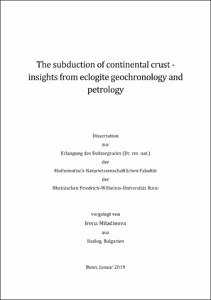The subduction of continental crust - insights from eclogite geochronology and petrology

The subduction of continental crust - insights from eclogite geochronology and petrology

| dc.contributor.advisor | Froitzheim, Nikolaus | |
| dc.contributor.author | Miladinova, Irena | |
| dc.date.accessioned | 2020-04-26T20:51:06Z | |
| dc.date.available | 2020-04-26T20:51:06Z | |
| dc.date.issued | 09.07.2019 | |
| dc.identifier.uri | https://hdl.handle.net/20.500.11811/8032 | |
| dc.description.abstract | When continents collide slices of continental crust may be dragged down into the subduction zone to depths of up to 200 km. The most straightforward evidence for continental subduction refers to the presence of high-pressure (HP) and ultrahigh-pressure (UHP) eclogite terranes in many collisional mountain systems. In addition, as inferred from numerical modelling continental subduction provides a physically most consistent explanation for the formation and exhumation of these terranes. Reconstruction of the P-T-t paths of HP and UHP rocks can provide direct constraints on the thermo-mechanical processes in subduction zones. For that, a multidisciplinary approach is the most promising one for understanding the subduction dynamics as well as the mechanisms of continental convergence. Three case studies were performed on HP and UHP eclogite terranes following similar procedures: the Eoalpine high-pressure belt in the Eastern Alps (Austria and Italy), the Byala Reka Dome in the Eastern Rhodopes (Bulgaria) and the Lofoten basement in the Scandinavian Caledonides (Norway). High precision Lu-Hf geochronology was applied on eclogites and combined with characterization of the chemical zoning in garnet. Additionally, thermodynamic modelling was performed on each of the dated samples for constraining the metamorphic conditions. The Eoalpine belt includes (ultra)high-pressure rocks that crop out along a northwest-southeast trending line extending from the Texel Complex in Italy to the Pohorje Mountains in Slovenia. Dating of garnet growth during pressure increase was achieved by using Lu-Hf chronometry that yielded results between c. 100 and c. 90 Ma. This time span of c. 10 Ma suggests short-lived period of subduction. Combined with the already published data the estimated metamorphic conditions indicate a field gradient with increasing P and T from northwest to southeast where the rocks experienced UHP Eoalpine metamorphism. The oldest Cretaceous eclogites are found in the Saualpe-Koralpe area that comprises widespread Permian gabbros formed along rift zones within a thinned continental margin during Permian-Triassic time. This supports the hypothesis that subduction initiation was intracontinental and localized by e Permian rift. In Texel Complex Lu-Hf dating of two-phased garnets yielded a Variscan-Eoalpine mixed age indicating re-subduction and eclogitization of Variscan eclogites during the Eoalpine orogeny. In eclogite from the Byala Reka Dome in the Eastern Rhodopes, garnet growth was dated at 81.6 ± 3.5 Ma by Lu–Hf chronometry. Petrological data and modelling suggest peak-pressure conditions of 1.2–1.6 GPa and 570–620 °C. The eclogite-facies metamorphism coincides with the main phase of granitoid intrusions in the Sredna Gora Zone and, thus, suggests that metamorphism took place in a subduction zone dipping towards north under this section of the Apuseni–Banat–Timok–Sredna Gora continental magmatic arc. During the Late Cretaceous, the site of magmatic activity shifted southward and arrived in the Eastern Rhodopes at ~69 Ma, as evident by granite intrusions of that age near the locality of the dated eclogite sample. This proximity may be explained by south-directed rollback of the subduction zone, although also post-69 Ma tectonic displacement has to be considered. Together with published age data from other parts of the Rhodopes, the new data confirm that multiple subduction/exhumation cycles took place between ~200 and ~40 Ma along this section of the southern European plate boundary. The Proterozoic basement of the Lofoten Islands contains Caledonian eclogite, although Caledonian deformation is only minor. Previous dating suggested that HP metamorphism in Lofoten occurred ca. 480 Ma, i.e., ~50 Ma before the collision between the major continents Baltica and Laurentia. Therefore, the Lofoten basement was considered not to originate from Baltica but rather to represent a stranded microcontinent. Newly discovered kyanite-bearing eclogites from the Lofoten Islands record deep subduction of continental crust during the main (Scandian) stage of Baltica-Laurentia collision ca. 400 Ma. Conventional geothermobarometry and thermodynamic modelling yield metamorphic conditions of 2.5-2.8 GPa and ~650 °C. Lu-Hf dating results in prograde garnet growth age of 399 ± 10 Ma. These results demonstrate that the Lofoten basement belonged to Baltica, was subducted to ~90 km depth during the collision with Laurentia, and was exhumed at an intermediate to high rate (>6 mm/yr) while thrusting of a Caledonian allochthon (Leknes Group) was still ongoing. This supports the challenging conclusions that (1) subducted continental crust may stay rigid down to a depth of ~90 km, and (2) it may be exhumed during ongoing collision and crustal shortening. | en |
| dc.language.iso | eng | |
| dc.rights | In Copyright | |
| dc.rights.uri | http://rightsstatements.org/vocab/InC/1.0/ | |
| dc.subject.ddc | 550 Geowissenschaften | |
| dc.title | The subduction of continental crust - insights from eclogite geochronology and petrology | |
| dc.type | Dissertation oder Habilitation | |
| dc.publisher.name | Universitäts- und Landesbibliothek Bonn | |
| dc.publisher.location | Bonn | |
| dc.rights.accessRights | openAccess | |
| dc.identifier.urn | https://nbn-resolving.org/urn:nbn:de:hbz:5n-55023 | |
| ulbbn.pubtype | Erstveröffentlichung | |
| ulbbnediss.affiliation.name | Rheinische Friedrich-Wilhelms-Universität Bonn | |
| ulbbnediss.affiliation.location | Bonn | |
| ulbbnediss.thesis.level | Dissertation | |
| ulbbnediss.dissID | 5502 | |
| ulbbnediss.date.accepted | 07.06.2019 | |
| ulbbnediss.institute | Mathematisch-Naturwissenschaftliche Fakultät : Fachgruppe Erdwissenschaften / Steinmann-Institut für Geologie, Mineralogie und Paläontologie | |
| ulbbnediss.fakultaet | Mathematisch-Naturwissenschaftliche Fakultät | |
| dc.contributor.coReferee | Nagel, Thorsten J. |
Files in this item
This item appears in the following Collection(s)
-
E-Dissertationen (4306)




